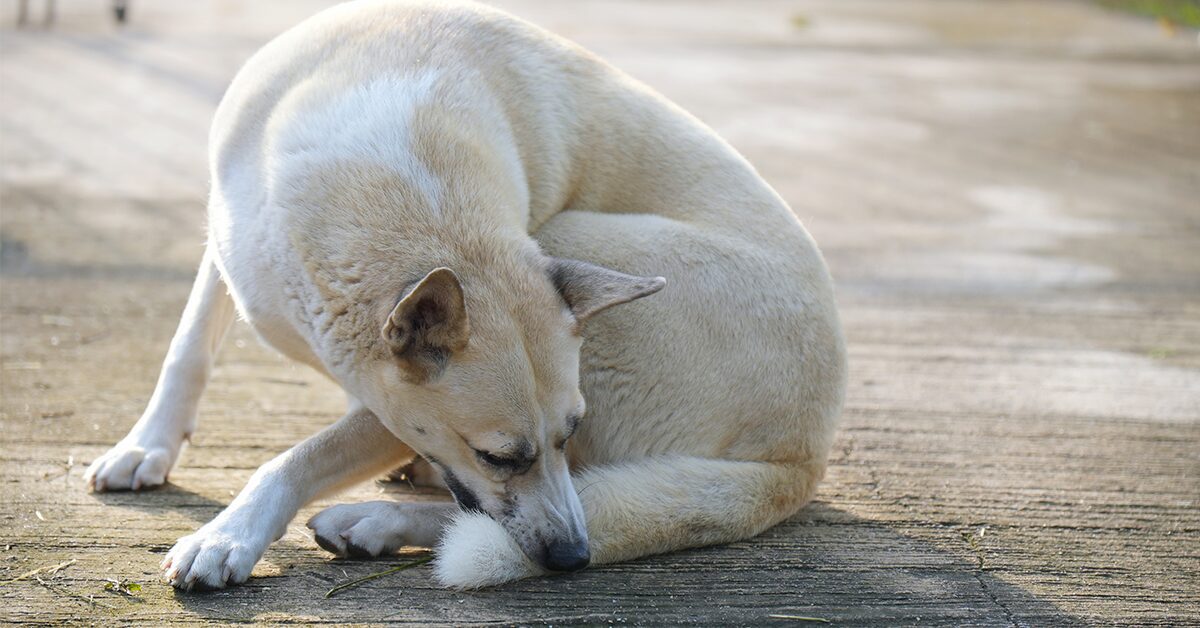Have you noticed your pooch repeatedly scratching or gnawing at their skin? A hot spot may be to blame.
Hot spots are a common but painful ailment for dogs that develop as a result of repeated aggravation of an already irritated area. The initial irritation may be caused by a number of factors, but it’s your dog’s natural response – biting, licking, or scratching the area – that causes it to develop into a hot spot. A hot spot will often ooze pus, leading to crusty or matted fur in the surrounding area.
Once your veterinarian has addressed the underlying cause of the hotspot, they can treat the affected area and prevent future flareups.
Symptoms
Hot spots begin as small lesions on your dog’s body which may resemble insect bites. However, as the infection develops further, they’ll spread beyond the initially affected area and begin oozing pus, causing your dog considerable pain. You may also notice hair loss in your dog.
Causes
- Inflammation and bacterial infections can occur when your dog bites, excessively licks, or scratches an itchy area on their skin
- Itchiness can be caused by parasites (mites, ticks, and fleas), food allergies, stress or boredom, skin infections like pyoderma, poor grooming, atopic or acute moist dermatitis, or sac disease affecting the anal gland, among other factors
- Dogs with frequently moist coats due to regular swimming or rain exposure are more likely to develop hot spots
Diagnosis
- Hot spots are typically visible and well-defined, with dogs exhibiting matted fur and scabs
- The diagnosis process focuses on identifying underlying factors
- This may include blood tests and allergy tests
Treatment
When it comes to treatment, vets first focus on identifying the underlying cause of your dog’s hot spot. If it’s the result of an allergic reaction, for example, your vet will try to identify what kind of allergy – for instance, food allergies – leads to distress and subsequent hot spot development. Once you know the cause of the hot spot, you have a better idea of how to treat it.
Applying antibiotics and antiseptics, like chlorhexidine or cortisone, to the infected area will kill bacteria and stem the infection. Topical medications and ointments can offer further help and reduce your dog’s pain. Oral antibiotics may also be prescribed. In order to prevent further scratching, your vet may give your dog an Elizabethan collar aka a cone, so they can’t bite at their hot spot.
Recovery and care
After treatment, hot spots usually clear up in a matter of days. You might cover the irritated area with a bandage or sock to prevent biting or scratching. Honey, surprisingly enough, can help soothe pain from hot spots. Be sure to continue the prescribed treatment plan as your veterinarian deems appropriate.
Prevention
To prevent hot spots in dogs, it’s important to keep your dog well-groomed and clean. Avoiding matted fur and maintaining healthy skin is essential. Other underlying causes require different treatments. Allergy medication, supplements, chlorhexidine shampoo – it all depends on what initially caused the irritation.
What to expect at the vet’s office
Your vet will begin by identifying potential underlying causes for skin irritation. Addressing the underlying cause is a key part of treatment, and can help prevent future hot spots from breaking out. They may perform blood tests and allergy tests. They’ll also ask you about your pup’s medical history to identify possible causes. Some underlying conditions causing hot spots require more work to address correctly.
Always ask your vet before giving any human medication to your dog. Although these are sometimes effective, they can also have adverse effects on your dog’s health.
The bottom line
Hot spots are not difficult to treat, but they can certainly be painful for your pup. Try to identify hot spots while they’re still in the early stages to bring your sweet pooch relief as soon as possible. By keeping up with regular grooming and monitoring your dog for flea bites, you are more likely to stop potential causes of hot spots in their tracks. The last thing you want is a secondary infection to arise and cause more serious health problems for your dog, so getting to the vet sooner rather than later is important.
FAQs
Are certain kinds of dogs more likely to develop hot spots?
Any dog can develop a hot spot. However, certain breeds of dogs such as Labrador Retrievers, Rottweilers, and German Shepherds are more susceptible to hot spots because of their thicker fur. If you have one of these breeds, proper grooming is even more important.
What can I do to treat my dog’s hot spots?
There are certain remedies you can do at home, like giving your pup soothing baths or using gauze, but you should always consult your veterinarian to be sure you’re doing enough.
Does pet insurance cover hot spot treatments?
Pet insurance can help cover the cost of hot spot treatments unless they are the result of a pre-existing condition, which most pet insurance plans do not cover.
Did you know?
- Hot spots can arise as the result of any condition causing itchiness, including stress or boredom.
- Engaging your dog with toys and other distractions can help prevent hot spots.



